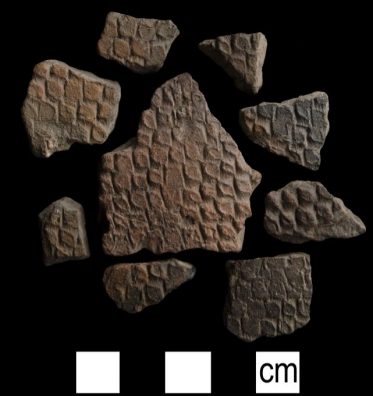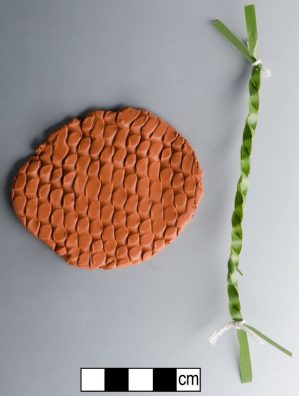Voted the Best Place to See by Condé Nast Traveler.


Captions Fig. 1: Nine colonoware sherds excavated from the Drayton Hall South Flanker well, exhibiting a rouletted pattern. These sherds are all likely from the same vessel, judging by paste and decoration similarities. Courtesy Drayton Hall Archeaological Collection
In a collaborative effort between Southeastern archaeologists, Drayton Hall (Charleston, SC) Wexler Curatorial Fellow Corey Heyward is identifying ways to recognize West African potting traditions on locally made, low-fired ceramics known as colonoware. Although Historical Archaeology is known for its use of documentary sources, there are several marginalized groups like Native Americans and enslaved Africans whose histories were never written down. Therefore, archaeologists must use material culture, ethnographic evidence, and other non-documentary sources to recover some of these stories. Colonoware encompasses pottery produced by Native Americans and Africans during the colonial period. The traditional pottery-making techniques associated with each of these groups shifted as they adjusted to colonialism, slavery, and a European market. Due to this exchange of practices, distinguishing colonoware produced by Native Americans versus enslaved Africans can be difficult—and this question has raised much debate within Historical Archaeology.
That said, certain decorative elements on colonoware can offer details about who was making these ceramics. A previously mis-identified decoration observed in two 18th-century assemblages from Drayton Hall and Heyward-Washington House (FIG. 1) led to the discovery of a traditional West African technique called rouletting. A roulette is any object that is rolled across the surface of a vessel to create a repeating pattern. This can be anything, such as a cord-wrapped stick, an industrialized rolling stamp, or even plastic materials used in modern times. It is and was a widely used technique—even popular on British 19th-century ceramics—and with the help of West African ethnographers, the Charleston colonoware was identified as being decorated with a folded strip roulette, which was made using vegetal materials.
Heyward experimented with making a roulette like the ones that would have been rolled on these colonoware vessels three hundred years ago (FIG. 2). Using palm fronds, she successfully reproduced the tool, which makes an impression identical to the sherds from Drayton Hall and the Heyward-Washington House. The identification of this decoration as specifically West African in its heritage—and its absence from Native American culture—is pivotal for determining colonoware made by enslaved Africans during the 18th and 19th centuries.

Fig. 2: Experimental roulette made from palm fronds and its impression on modeling clay. The roulette is made using two strips of palm, twisted and folded together. Then, it is rolled across the clay to produce a pattern that repeats every third column.
Along with colleagues Jon Marcoux (Clemson/College of Charleston Graduate Program in Historic Preservation), Martha Zierden (The Charleston Museum), Ron Anthony (The Charleston Museum), and Sarah Platt (The Digital Archaeological Archive of Comparative Slavery, Monticello; Syracuse University), (Tag DAACS and the other affiliated institutions?) Heyward continues to research this decorative technique and study Lowcountry colonoware in order to better understand the marginalized communities of Charleston during the colonial period. Marcoux organized a colonoware workshop in July for Southeastern archaeologists studying this ceramic, a meeting which aimed to learn from each other’s research and discuss future work. This collaboration is important for understanding the people who produced these ceramics, and future meetings will be aimed at continuing this discourse and necessary research. (Link to Behre’s article and Archaeology Magazine article?)
Fig. Captions
Fig. 1: Nine colonoware sherds excavated from the Drayton Hall South Flanker well, exhibiting a rouletted pattern. These sherds are all likely from the same vessel, judging by paste and decoration similarities.
Fig. 2: Experimental roulette made from palm fronds and its impression on modeling clay. The roulette is made using two strips of palm, twisted and folded together. Then, it is rolled across the clay to produce a pattern that repeats every third column.